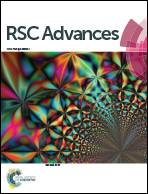Rapid 18F-radiolabeling of peptides from [18F]fluoride using a single microfluidics device†
Abstract
To date the majority of 18F-peptide radiolabeling approaches are multi-step, low yielding and time-consuming processes. Given the short half-life of 18F (109.8 min), it is critical that methods are developed to increase the efficiency of this process with simpler, higher yielding and faster reactions that can be rapidly translated into clinical use. Here, we demonstrate the first microfluidic synthesis of the [18F]F-Py-TFP prosthetic group with radiochemical yields of up to 97% and a synthesis time of 3 min. In addition, we utilized a single microfluidics device to prepare the [18F]F-Py-YGGFL peptide using [18F]F-Py-TFP, from [18F]fluoride in a two-step, fully automated approach. The model peptide NH2-YGGFL was radiolabeled with [18F]F-Py-TFP in up to 28% overall radiochemical yield within 8 minutes starting from anhydrous [18F]fluoride.
![Graphical abstract: Rapid 18F-radiolabeling of peptides from [18F]fluoride using a single microfluidics device](/en/Image/Get?imageInfo.ImageType=GA&imageInfo.ImageIdentifier.ManuscriptID=C4RA10520F&imageInfo.ImageIdentifier.Year=2014)

 Please wait while we load your content...
Please wait while we load your content...